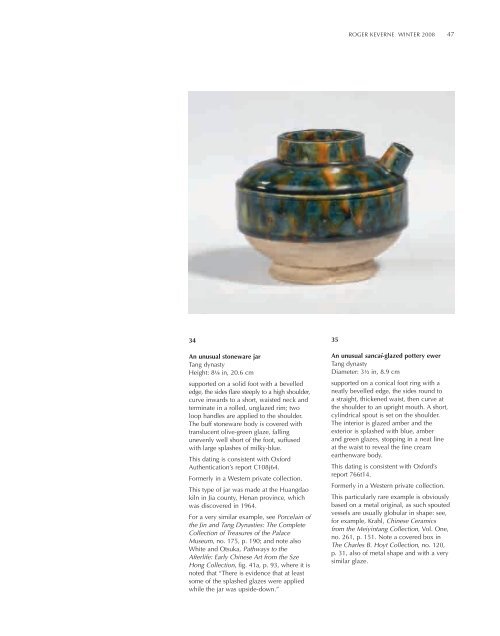WINTER EXHIBITION 2008 - Roger Keverne
WINTER EXHIBITION 2008 - Roger Keverne
WINTER EXHIBITION 2008 - Roger Keverne
Create successful ePaper yourself
Turn your PDF publications into a flip-book with our unique Google optimized e-Paper software.
34<br />
An unusual stoneware jar<br />
Tang dynasty<br />
Height: 8B in, 20.6 cm<br />
supported on a solid foot with a bevelled<br />
edge, the sides flare steeply to a high shoulder,<br />
curve inwards to a short, waisted neck and<br />
terminate in a rolled, unglazed rim; two<br />
loop handles are applied to the shoulder.<br />
The buff stoneware body is covered with<br />
translucent olive-green glaze, falling<br />
unevenly well short of the foot, suffused<br />
with large splashes of milky-blue.<br />
This dating is consistent with Oxford<br />
Authentication’s report C108j64.<br />
Formerly in a Western private collection.<br />
This type of jar was made at the Huangdao<br />
kiln in Jia county, Henan province, which<br />
was discovered in 1964.<br />
For a very similar example, see Porcelain of<br />
the Jin and Tang Dynasties: The Complete<br />
Collection of Treasures of the Palace<br />
Museum, no. 175, p. 190; and note also<br />
White and Otsuka, Pathways to the<br />
Afterlife: Early Chinese Art from the Sze<br />
Hong Collection, fig. 41a, p. 93, where it is<br />
noted that “There is evidence that at least<br />
some of the splashed glazes were applied<br />
while the jar was upside-down.”<br />
35<br />
ROGER KEVERNE <strong>WINTER</strong> <strong>2008</strong> 47<br />
An unusual sancai-glazed pottery ewer<br />
Tang dynasty<br />
Diameter: 3I in, 8.9 cm<br />
supported on a conical foot ring with a<br />
neatly bevelled edge, the sides round to<br />
a straight, thickened waist, then curve at<br />
the shoulder to an upright mouth. A short,<br />
cylindrical spout is set on the shoulder.<br />
The interior is glazed amber and the<br />
exterior is splashed with blue, amber<br />
and green glazes, stopping in a neat line<br />
at the waist to reveal the fine cream<br />
earthenware body.<br />
This dating is consistent with Oxford’s<br />
report 766t14.<br />
Formerly in a Western private collection.<br />
This particularly rare example is obviously<br />
based on a metal original, as such spouted<br />
vessels are usually globular in shape: see,<br />
for example, Krahl, Chinese Ceramics<br />
from the Meiyintang Collection, Vol. One,<br />
no. 261, p. 151. Note a covered box in<br />
The Charles B. Hoyt Collection, no. 120,<br />
p. 31, also of metal shape and with a very<br />
similar glaze.


